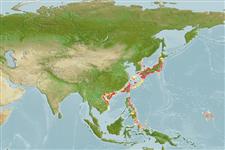Teleostei (teleosts) >
Kurtiformes (Nurseryfishes, cardinalfishes.) >
Apogonidae (Cardinalfishes) > Pseudamiinae
Etymology: Gymnapogon: Greek, gymnos = naked + Greek, pogon = beard (Ref. 45335).
More on author: Regan.
Environment: milieu / climate zone / depth range / distribution range
Ecology
Marine; benthopelagic. Tropical
Western Pacific: Japan to the Philippines.
Size / Weight / Age
Maturity: Lm ? range ? - ? cm
Max length : 5.0 cm TL male/unsexed; (Ref. 559)
Dorsal spines (total): 7; Dorsal soft rays (total): 10; Anal spines: 2; Anal soft rays: 9. Body similar to gobioid fishes. No scales on body, but with many well-developed pit organs on head and body. The fan-like caudal fin has many procurrent rays. There is a single downward short spine on the preopercular edge, and many dark-brownish pigments on the caudal peduncle.
Sometimes taken by trawl net, and found in the open sea (Ref. 559).
Life cycle and mating behavior
Maturity | Reproduction | Spawning | Eggs | Fecundity | Larvae
Distinct pairing during courtship and spawning (Ref. 205).
Masuda, H., K. Amaoka, C. Araga, T. Uyeno and T. Yoshino, 1984. The fishes of the Japanese Archipelago. Vol. 1. Tokai University Press, Tokyo, Japan. 437 p. (text). (Ref. 559)
IUCN Red List Status (Ref. 130435: Version 2024-1)
Threat to humans
Harmless
Human uses
Fisheries: of no interest
Tools
Special reports
Download XML
Internet sources
Estimates based on models
Preferred temperature (Ref.
123201): 15 - 28.9, mean 25.6 °C (based on 84 cells).
Phylogenetic diversity index (Ref.
82804): PD
50 = 0.5039 [Uniqueness, from 0.5 = low to 2.0 = high].
Bayesian length-weight: a=0.00389 (0.00180 - 0.00842), b=3.12 (2.94 - 3.30), in cm total length, based on all LWR estimates for this body shape (Ref.
93245).
Trophic level (Ref.
69278): 3.3 ±0.5 se; based on size and trophs of closest relatives
Resilience (Ref.
120179): High, minimum population doubling time less than 15 months (Preliminary K or Fecundity.).
Fishing Vulnerability (Ref.
59153): Low vulnerability (10 of 100).
